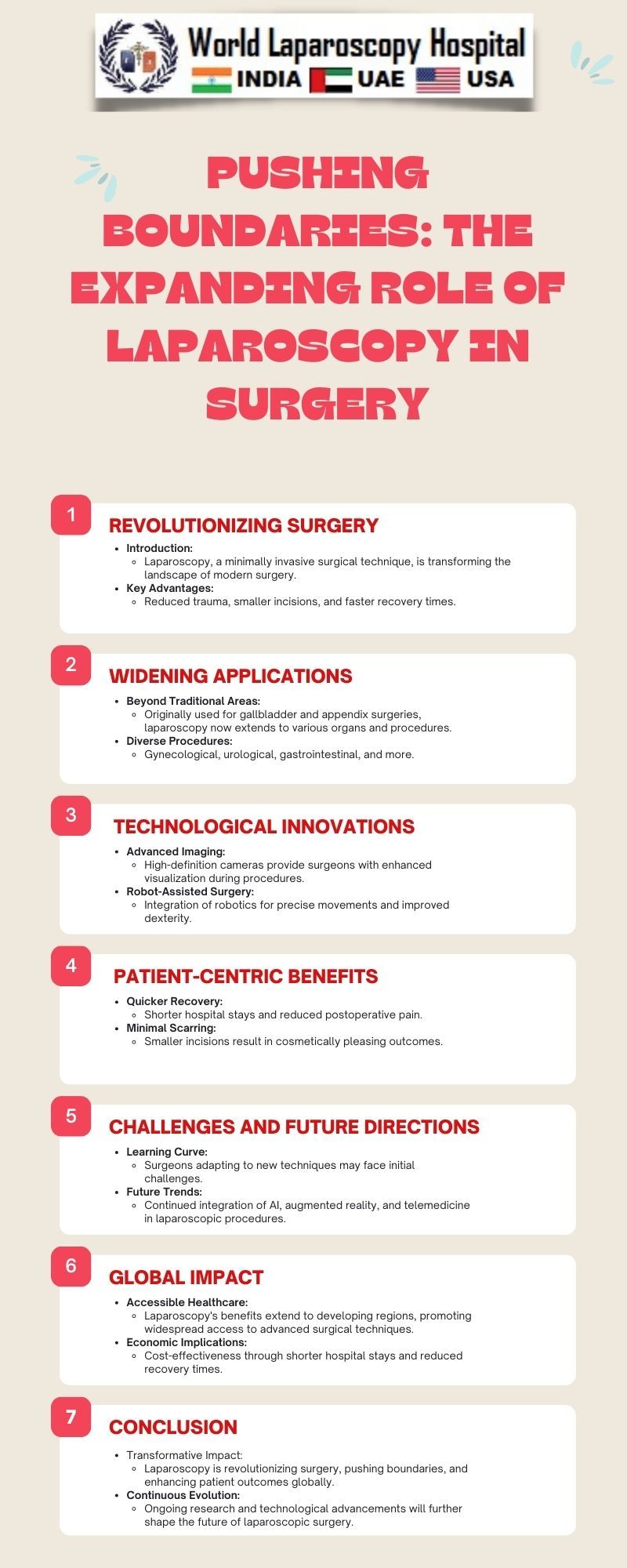Introduction:
In the ever-evolving landscape of medical science, one innovation has significantly transformed surgical practices—laparoscopy. Originally developed as a diagnostic tool, laparoscopy has transcended its initial role to become a cornerstone in the realm of surgery. This article explores the rich history, current applications, and future prospects of laparoscopy, delving into the ways it is pushing the boundaries of what was once thought possible in the operating room.

The Evolution of Laparoscopy: From Diagnosis to Intervention
Historical Roots
Laparoscopy's roots trace back to the early 20th century, with the first attempts at exploring the abdominal cavity using rudimentary instruments. However, it was not until the 1970s that laparoscopy truly began to take shape, thanks to the pioneering work of individuals like Dr. George Kelling and Dr. Hans-Christian Jacobaeus. Their groundbreaking efforts laid the foundation for a transformative surgical technique that would revolutionize the field.
Diagnostic Beginnings
Initially employed primarily for diagnostic purposes, laparoscopy provided a non-invasive means to visualize the abdominal organs. The advent of fiber-optic technology in the 1980s marked a significant milestone, enabling clearer and more detailed imaging. Surgeons could now diagnose conditions such as appendicitis, gallstones, and tumors with increased precision, reducing the need for more invasive exploratory procedures.
Expanding Applications: Beyond Diagnostics to Interventions
Minimally Invasive Surgery (MIS)
The real turning point for laparoscopy was its evolution into a therapeutic tool for minimally invasive surgery (MIS). The concept of performing complex surgical procedures through small incisions with the aid of a camera opened new avenues for patient care. This shift represented a departure from traditional open surgeries, offering numerous advantages, including reduced postoperative pain, shorter hospital stays, and quicker recovery times.
Key Technological Advances
Technological advancements played a pivotal role in expanding the capabilities of laparoscopy. The development of high-definition cameras, improved lighting systems, and more sophisticated robotic-assisted platforms elevated the precision and range of procedures that could be performed laparoscopically. Surgeons could now tackle intricate surgeries with enhanced visibility and control, pushing the boundaries of what was considered feasible through small incisions.
Current Applications: A Panorama of Laparoscopic Procedures
Gastrointestinal Surgeries
Laparoscopy has become a cornerstone in gastrointestinal surgeries, encompassing procedures such as cholecystectomy, appendectomy, and colorectal surgeries. The ability to navigate through the intricate terrain of the abdomen with minimal invasiveness has led to a paradigm shift in the management of digestive disorders.
Gynecological Interventions
In gynecology, laparoscopy has become the gold standard for procedures like hysterectomy, ovarian cyst removal, and tubal ligation. The reduced trauma to surrounding tissues and quicker recovery have made it a preferred choice for many patients and surgeons alike.
Urological Advancements
The field of urology has witnessed a surge in laparoscopic applications, with procedures ranging from nephrectomy to prostatectomy. The improved visualization and dexterity offered by laparoscopic tools have opened up new possibilities for treating various urological conditions, contributing to better patient outcomes.
Cardiothoracic Innovations
Laparoscopy's influence has extended to cardiothoracic surgeries, with procedures like minimally invasive cardiac surgery and thoracoscopic lung surgeries gaining prominence. While these surgeries involve the chest rather than the abdomen, the principles of minimally invasive techniques remain consistent, showcasing the adaptability of laparoscopy across different anatomical regions.
Challenges and Future Directions
Learning Curve and Skill Acquisition
Despite its numerous advantages, laparoscopy presents a learning curve for surgeons. Mastering the skills required for precise manipulation of instruments and maintaining spatial orientation through a camera lens takes time and practice. As technology continues to advance, virtual reality and simulation tools may play a crucial role in expediting the learning process and ensuring the proficiency of future laparoscopic surgeons.
Expanding Frontiers: Robotic-Assisted Laparoscopy
The integration of robotics into laparoscopic procedures has opened up new possibilities for surgeons. Robotic-assisted laparoscopy combines the benefits of traditional laparoscopy with enhanced robotic capabilities, offering increased dexterity and precision. As these systems become more sophisticated, the potential for complex surgeries may expand even further.
Innovations in Imaging and Navigation
Advancements in imaging technology hold the key to further expanding the role of laparoscopy. Techniques such as fluorescence-guided surgery and augmented reality are being explored to provide real-time visualization of structures and enhance the surgeon's ability to navigate through complex anatomies. These innovations could revolutionize the way laparoscopy is employed, especially in challenging and intricate procedures.
Ethical Considerations and Patient-Centric Care
As laparoscopy continues to advance, ethical considerations surrounding patient safety, informed consent, and equitable access to cutting-edge procedures become increasingly crucial. Striking a balance between technological innovation and ensuring patient-centric care remains a priority, emphasizing the importance of ethical frameworks in guiding the future evolution of laparoscopic surgery.
Conclusion:
Laparoscopy's journey from a diagnostic tool to a cornerstone of modern surgery reflects the dynamic nature of medical innovation. Its expanding role, driven by technological progress and surgical creativity, has redefined the possibilities within the operating room. As we stand on the cusp of a new era in healthcare, the continued evolution of laparoscopy holds the promise of further pushing the boundaries of surgical intervention, ultimately improving patient outcomes and shaping the future of medicine.
